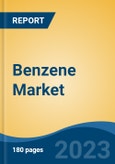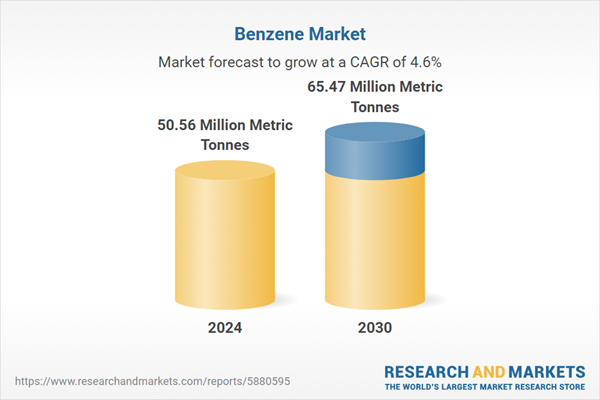Speak directly to the analyst to clarify any post sales queries you may have.
10% Free customizationThis report comes with 10% free customization, enabling you to add data that meets your specific business needs.
Rapid industrialization, particularly in Asia-Pacific, is driving market expansion through heightened consumption of downstream chemicals. However, regulatory scrutiny due to benzene’s carcinogenic classification, along with crude oil price fluctuations, present ongoing risks. Despite steady demand in mature markets like North America and Europe, new investments and capacity growth are increasingly concentrated in Asia and the Middle East. As sustainability concerns intensify, future market dynamics will be shaped by innovation, environmental compliance, and the gradual shift toward bio-based alternatives.
Key Market Drivers
Growing Demand of Benzene in Automotive Industry
The rising use of benzene in the automotive industry is significantly contributing to the growth of the global benzene market. As a key aromatic hydrocarbon, benzene plays an essential role in producing a wide range of automotive materials including plastics, synthetic fibers, rubber components, and resins. The global automotive sector witnessed strong activity in 2024, with vehicle production reaching 75.5 million units - highlighting growing demand for benzene-derived products used in interior panels, engine parts, and insulation materials. While production in the EU declined by 6.2%, Asia, led by China with a 5.2% rise, continues to dominate global output. South America also showed resilience, particularly in Brazil. These regional manufacturing trends underline the sustained and growing requirement for benzene-based materials, driven by efforts to reduce vehicle weight, improve fuel efficiency, and enhance performance across conventional and electric vehicle platforms.Key Market Challenges
Health and Safety Concerns
Health and environmental concerns present a considerable obstacle for the benzene market due to the compound's well-documented toxicity. Benzene is classified as a human carcinogen by institutions such as the IARC, with long-term exposure linked to serious conditions including leukemia and other blood disorders. This has prompted stringent regulatory enforcement, particularly across North America and Europe, where emission limits and occupational exposure standards are increasingly restrictive. Compliance with these regulations raises operational costs and limits benzene's application in sensitive industries such as consumer goods and packaging. Furthermore, growing public awareness and pressure for sustainable alternatives are encouraging end-users to shift toward non-toxic feedstocks. These factors are compelling chemical manufacturers to invest in safer processes and substitute materials, potentially moderating long-term demand for benzene in various downstream markets.Key Market Trends
Investment in Technological Advancements
Technological innovation is emerging as a key trend shaping the future of the benzene market. Producers are adopting advanced refining and petrochemical processes to enhance production efficiency, reduce environmental impact, and remain competitive amidst evolving regulatory frameworks. In a notable development, Tamilnadu Petroproducts Ltd partnered with EY-Parthenon in April 2024 to create a strategic sustainability roadmap. The collaboration focuses on achieving carbon neutrality by embedding environmental objectives into the company's operational and investment strategies. This initiative reflects a broader industry move toward greener manufacturing practices, improved energy utilization, and reduced emissions - ensuring alignment with global sustainability goals and bolstering long-term viability in the benzene value chain.Key Market Players
- Exxon Mobil Corporation
- Royal Dutch Shell PLC
- Sinopec Corporation
- JX Holdings Inc.
- Mitsubishi Corporation
- Maruzen Petrochemical Co., Ltd.
- The Dow Chemical Company
- Reliance Industries Limited
- BASF SE
- Evonik Industries AG
Report Scope:
In this report, the Global Benzene Market has been segmented into the following categories, in addition to the industry trends which have also been detailed below:Benzene Market, By Derivative:
- Ethylbenzene
- Aniline
- Phenol
- Alkyl Benzene
- Styrene
- Cumene
- Cyclohexane
- Nitrobenzene
- Others
Benzene Market, By End User:
- Automotive
- Mechanical & Engineering
- Construction
- Chemical
- Oil & Gas
- Petrochemical
- Others
Benzene Market, By Region:
- North America
- United States
- Canada
- Mexico
- Europe
- France
- United Kingdom
- Italy
- Germany
- Spain
- Asia Pacific
- China
- India
- Japan
- Australia
- South Korea
- South America
- Brazil
- Argentina
- Colombia
- Middle East & Africa
- South Africa
- Saudi Arabia
- UAE
Competitive Landscape
Company Profiles: Detailed analysis of the major companies present in the Global Benzene Market.Available Customizations:
With the given market data, the publisher offers customizations according to a company's specific needs. The following customization options are available for the report.Company Information
- Detailed analysis and profiling of additional market players (up to five).
This product will be delivered within 1-3 business days.
Table of Contents
Companies Mentioned
- Exxon Mobil Corporation
- Royal Dutch Shell PLC
- Sinopec Corporation
- JX Holdings Inc.
- Mitsubishi Corporation
- Maruzen Petrochemical Co., Ltd.
- The Dow Chemical Company
- Reliance Industries Limited
- BASF SE
- Evonik Industries AG
Table Information
| Report Attribute | Details |
|---|---|
| No. of Pages | 198 |
| Published | June 2025 |
| Forecast Period | 2024 - 2030 |
| Estimated Market Value in 2024 | 50.56 Million Metric Tonnes |
| Forecasted Market Value by 2030 | 65.47 Million Metric Tonnes |
| Compound Annual Growth Rate | 4.6% |
| Regions Covered | Global |
| No. of Companies Mentioned | 10 |









